Sunflowers are on my mind these days, in part because these sunflowers almost bonk me on the head every time I walk down the path in the photo above. Bees get scared as I get close, and they jump off the flowers to buzz around me. But I just can’t get myself to cut those sunflowers back off the path. They are so beautiful.
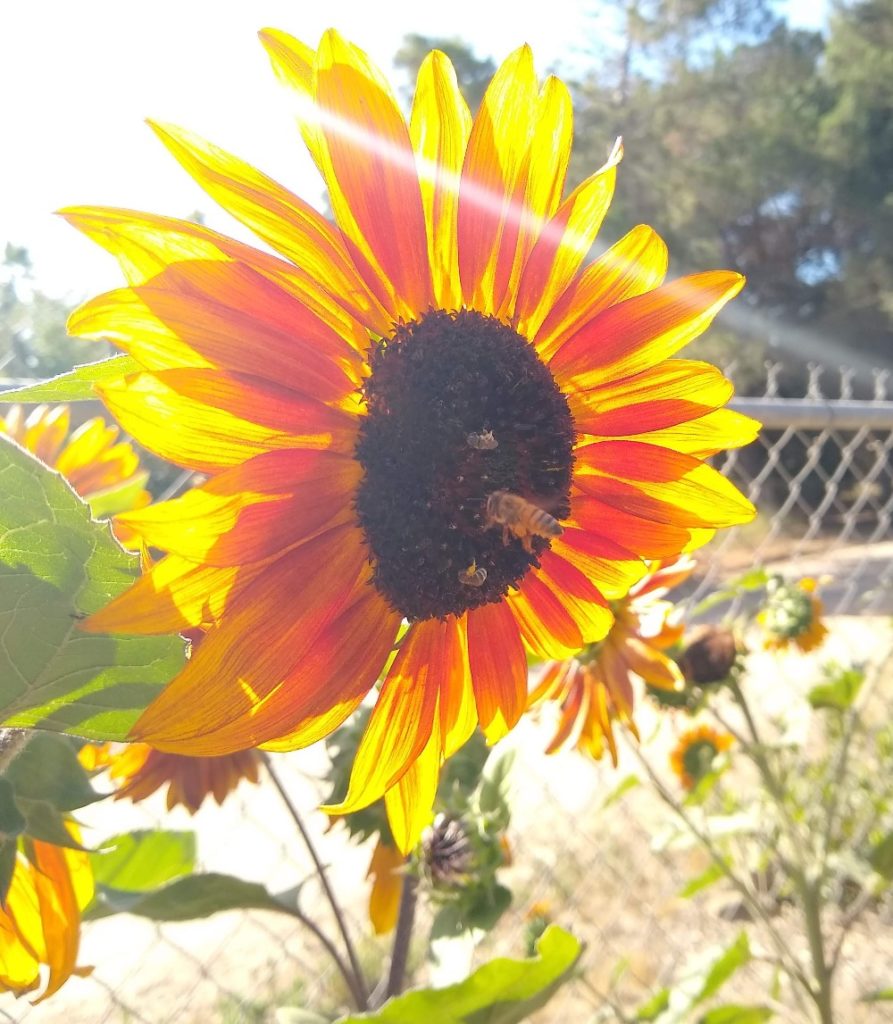
And sunflowers are so useful, as they provide food for the bees.
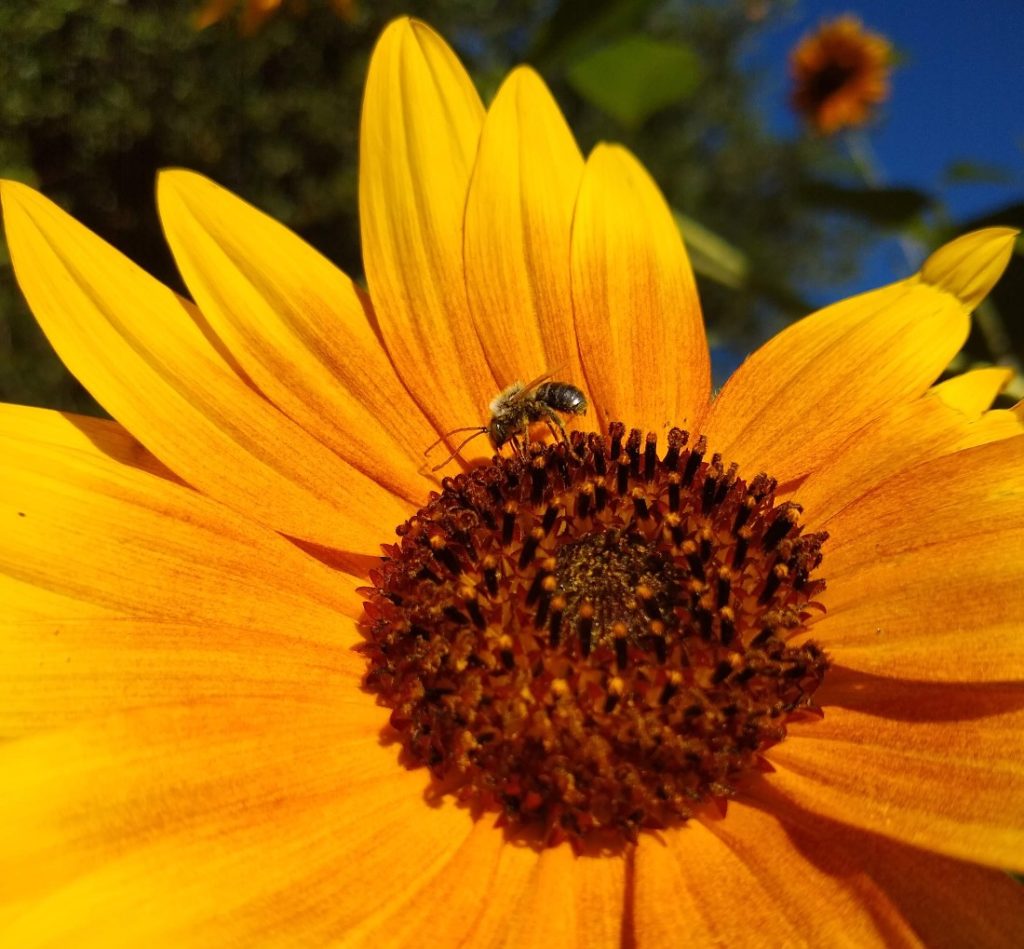
And they provide food for the birds as well.
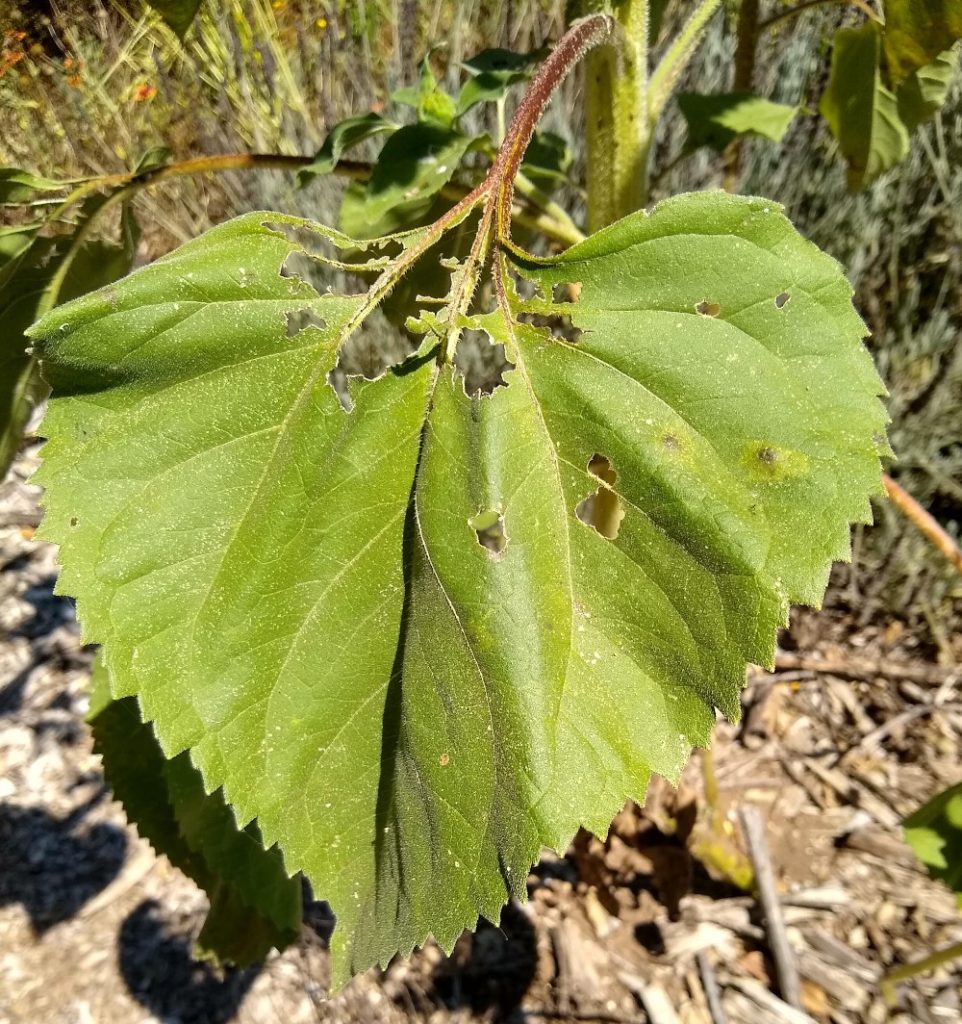
And sunflowers feed us.
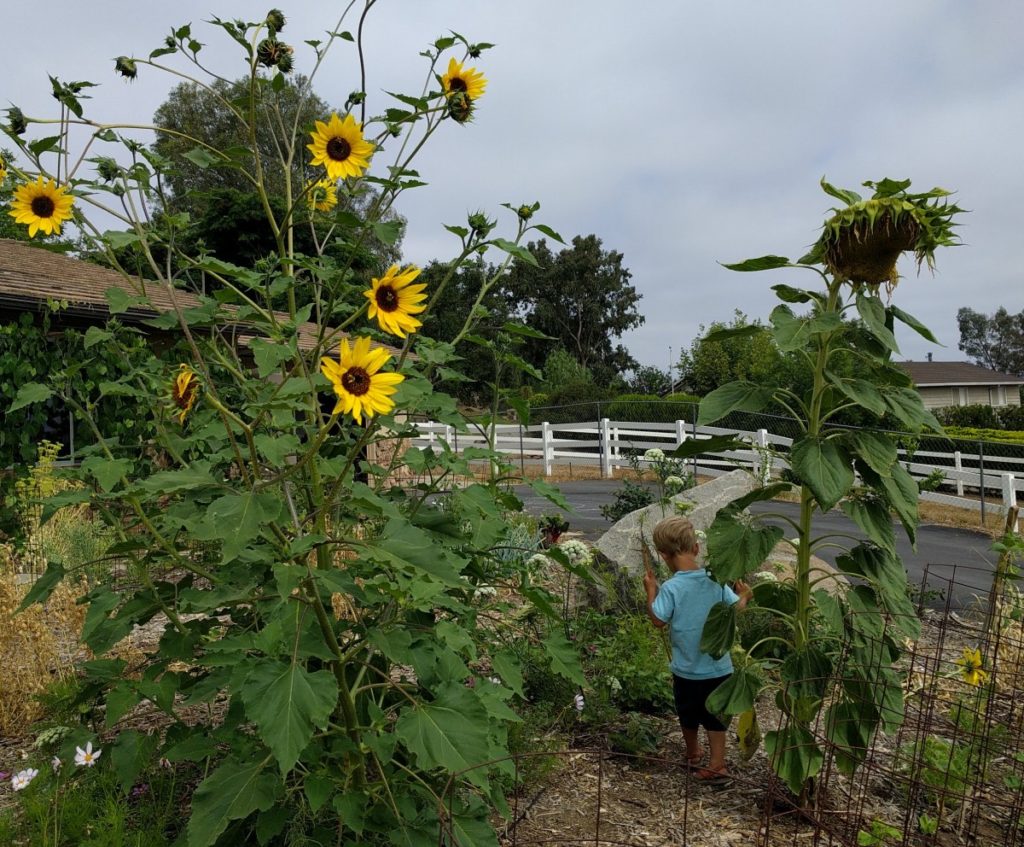
Varieties and uses
While we do have some native sunflowers that grow in Southern California, in this post I’m talking about the kinds of sunflowers that we cultivate, the kinds that have been bred for flowers of various colors, tastier seeds, or massive size.
If you want to impress neighbors, or your kids, grow a variety like ‘Mammoth’, which gets almost as tall as a tree. Here’s a ‘Mammoth’ sunflower that I grew a few years back:
If you want to feed the bees, grow ‘Lemon Queen’, which always has numerous bees visiting it in my yard.
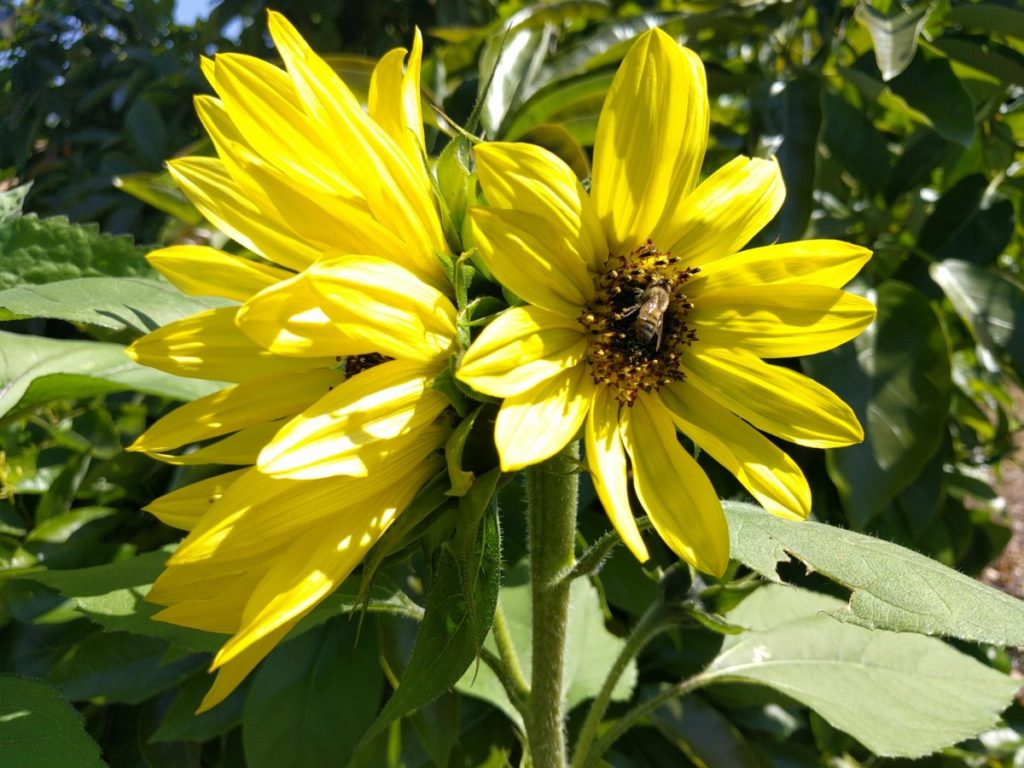
If you want bee visits and unexpected color in a sunflower, try ‘Velvet Queen’. (I grew my original Queens from the seeds sold by Botanical Interests called “Two Queens.”)
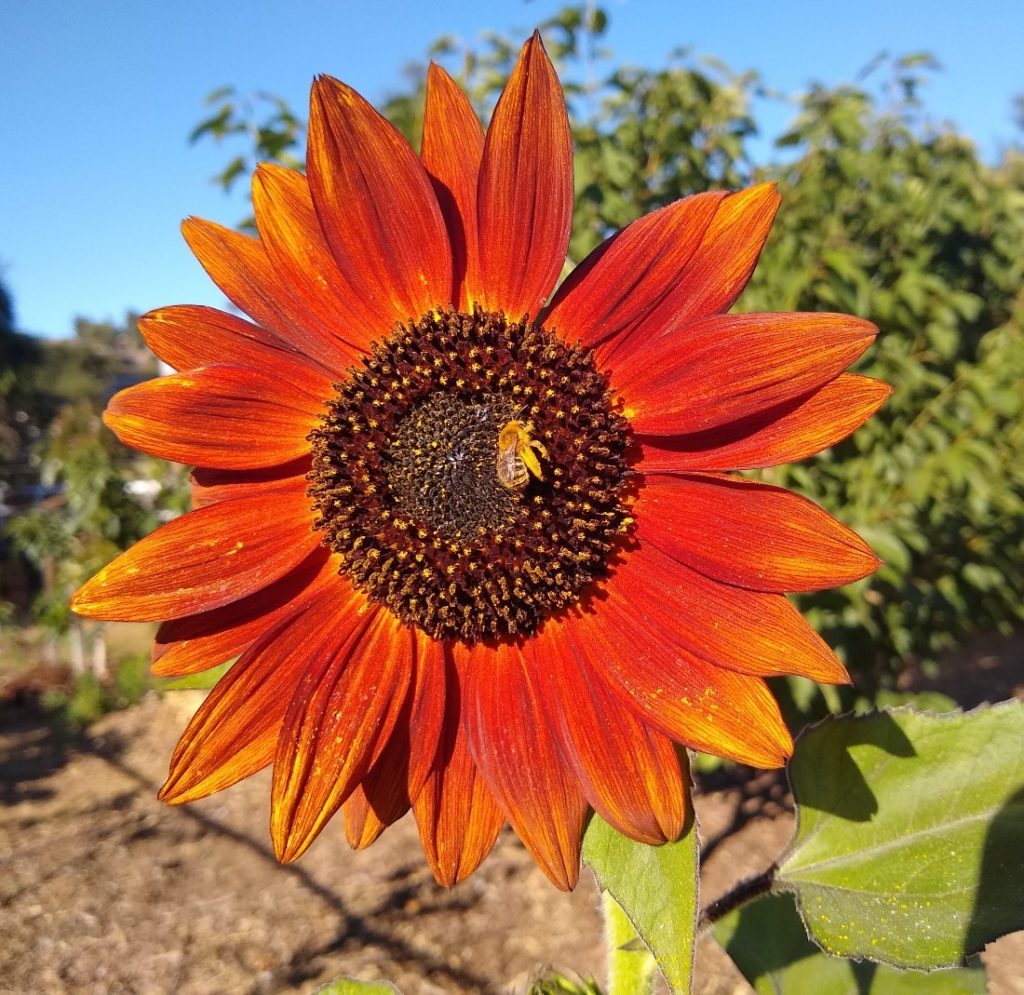
There are innumerable other sunflower cultivars. Some are short. Some don’t have pollen so when you cut a flower and put it in a vase on your table it doesn’t shed yellow dust. But I’m not sure about those. I’m thinking that sunflowers should be robust and more functional than table decoration. So I personally like to grow the above mentioned varieties or similar ones, or their self-sown progeny.
Letting sunflowers self-sow sometimes brings surprising results. This year, I have one plant that emerged with variegated foliage.
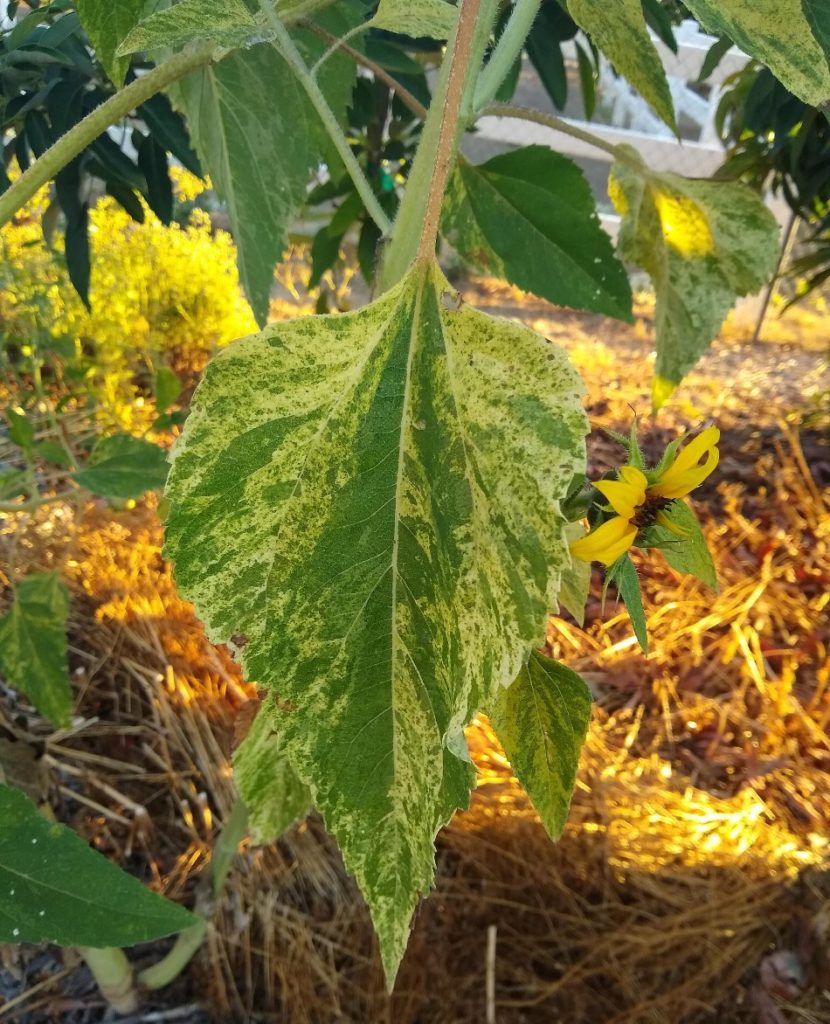
When to sow or plant
Sunflowers like to grow during the warmer months of the year. When I sow them, it’s usually starting in spring and going through the end of summer. But I have had sunflowers germinate and grow on their own in different parts of my yard throughout the entire year. They will grow through winter in Southern California if the spot is warm enough.
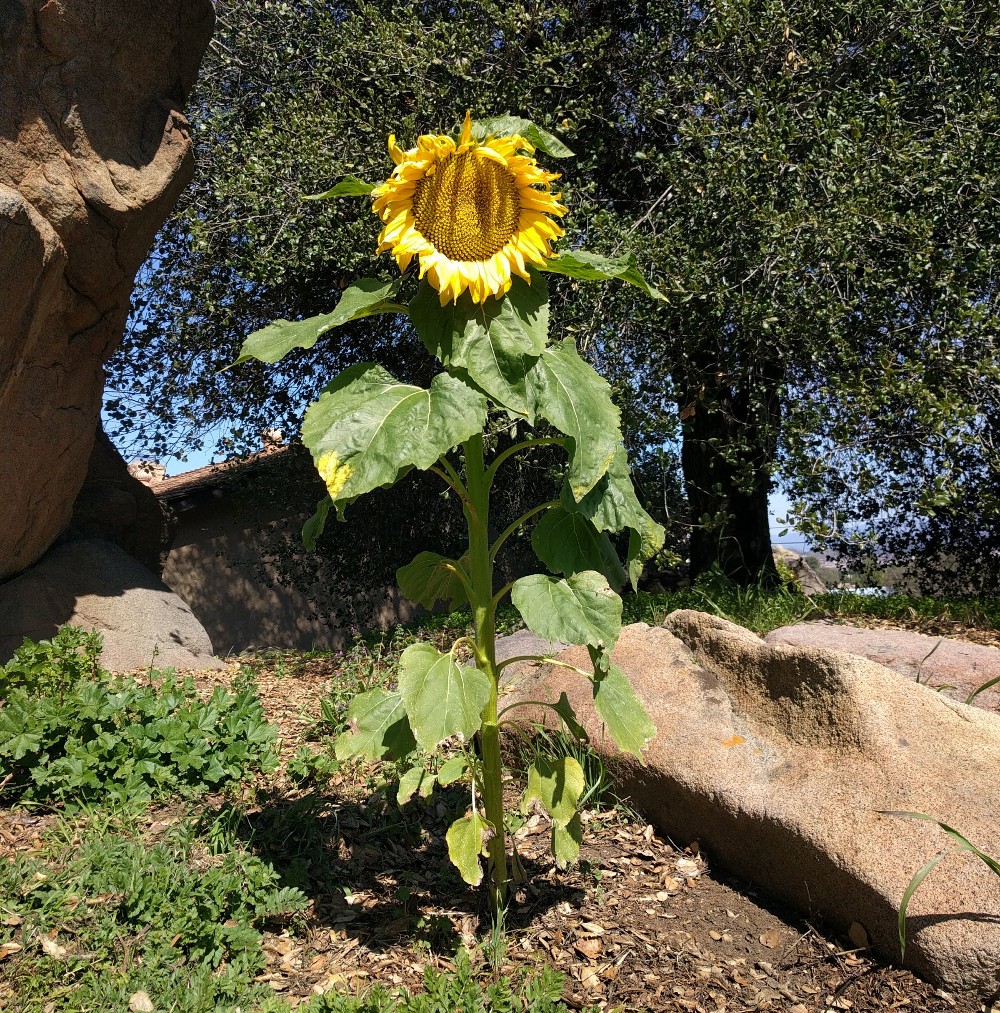
How do they grow on their own? The center of that sunflower becomes a mass of seeds, and even as the birds eat many of them, some shake loose and fall to the ground and some are dropped by the birds in other locations. Then when the conditions are right, the seeds germinate.
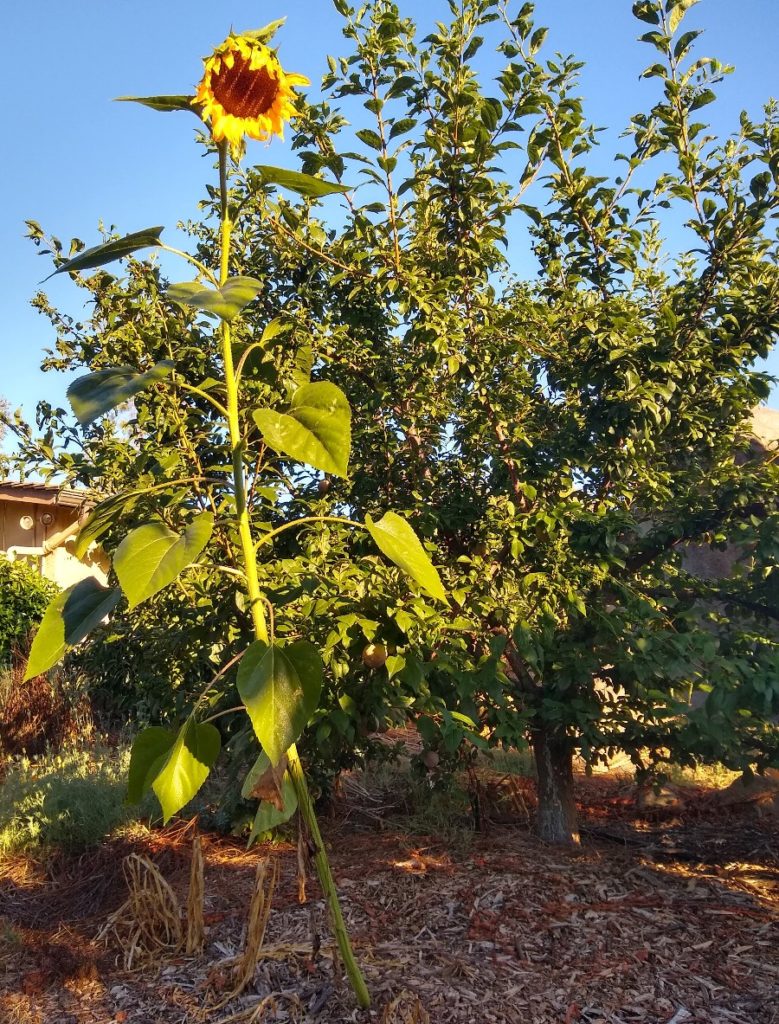
Cottontail rabbits will eat young sunflower plants so anytime I want to ensure that a sunflower plant matures I put a cage of poultry wire around it until the plant gets a couple feet tall.
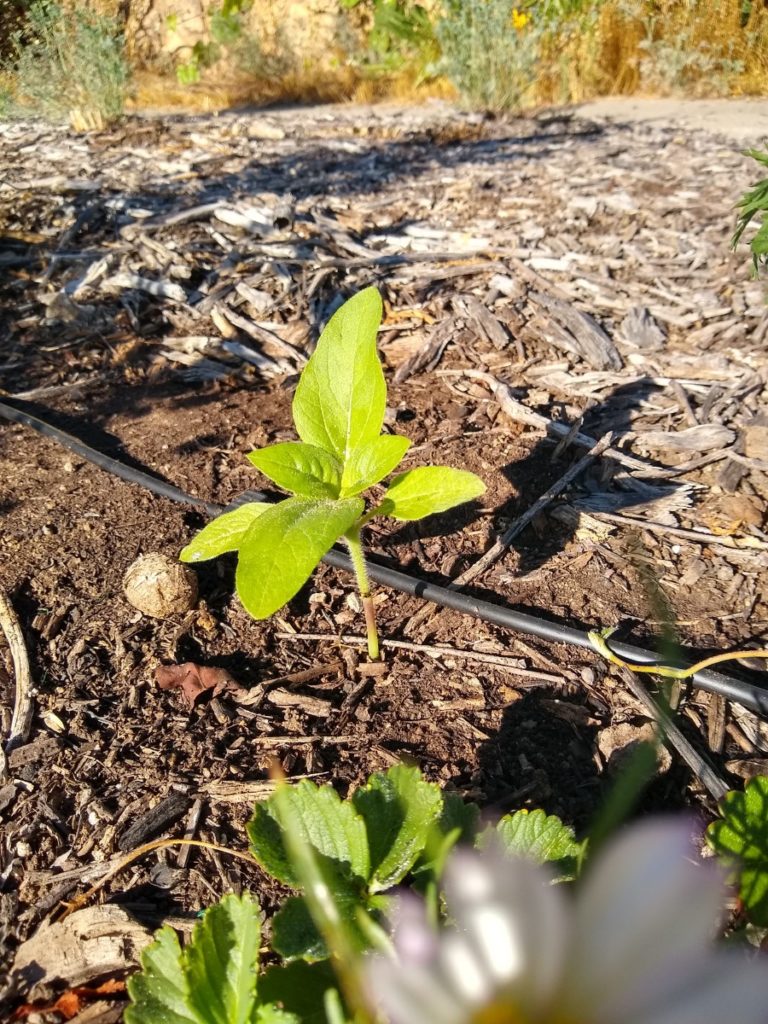
Instead of sowing sunflower seeds in modules or trays, or buying seedlings, I mostly sow seeds directly in the dirt wherever I want the plants to grow. If the soil is warm enough, the sunflower seed will germinate and grow incredibly fast. When I’ve sown sunflower seeds in modules in the past, I’ve had a hard time transplanting them before they get rootbound — that’s how fast they grow.
Spacing and arranging sunflower plantings
Ultimately, many sunflower varieties will get over ten feet tall, especially if they’re well watered. Because of this, I like to sow the seeds at the north end of vegetable beds. This way the sunflowers won’t shade the vegetables.
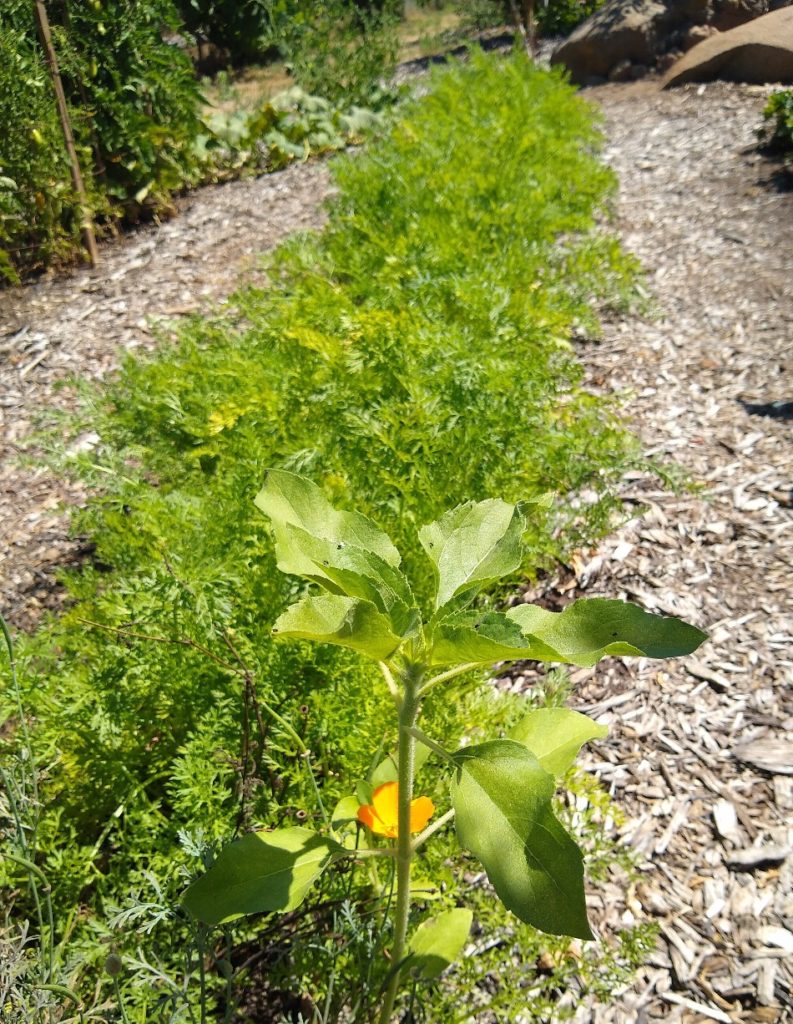
But if you’re only growing one or two sunflowers, then the shade won’t be too much for some sweet potatoes or watermelon vines to thrive underneath.
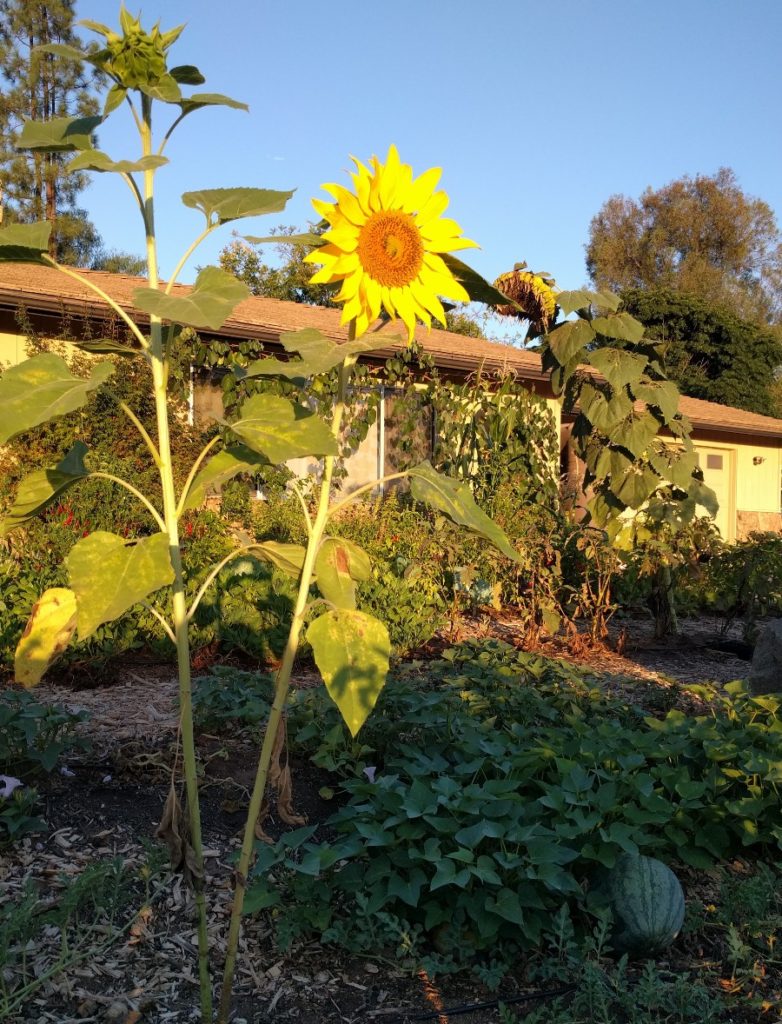
You can also use the sunflowers as a scaffold for other vegetables to climb on. One year, my son sowed peas under sunflowers and the pea vines climbed the sunflowers and yielded well. The point is that you don’t need to dedicate garden space to just sunflowers.
Watering
Up to a point, sunflowers grow taller and bloom more if you give them more water. However, they also grow well and bloom satisfactorily if they only get peripheral water. What I mean by peripheral water is if they are growing in proximity to other plants that are irrigated.
It so happens that all of the sunflowers that are currently blooming in my yard have self-sown, and they are growing without dedicated irrigation, but some are growing within reach of irrigation that is meant for other plants. These sunflowers are bigger and blooming more heavily than those without any irrigation nearby.
For example, these sunflowers along my driveway popped up on their own.
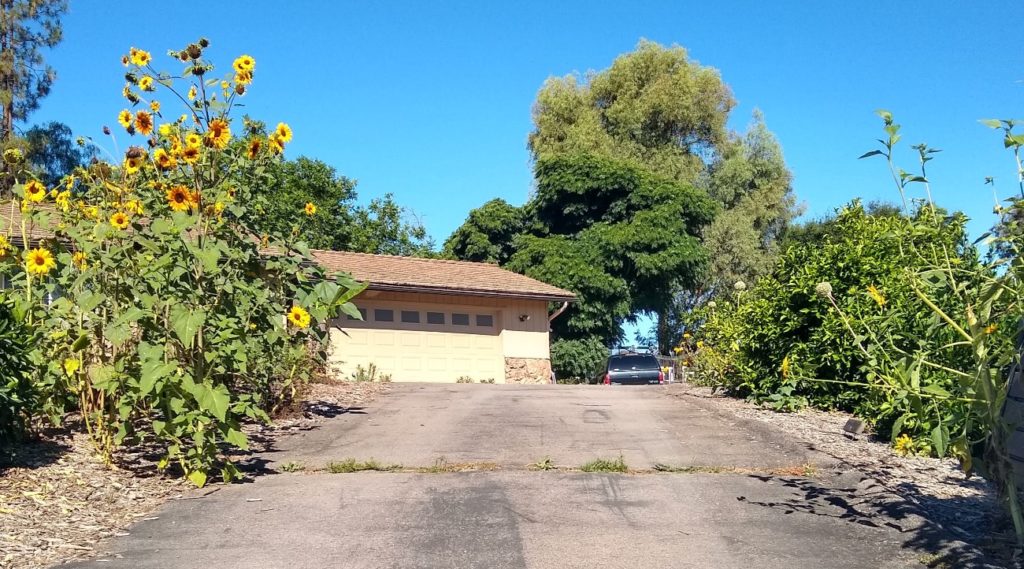
Beside the sunflowers on the left is my vegetable garden, which is irrigated of course. And beside the sunflowers on the right are some avocado trees, which are irrigated of course.
Sunflowers are adept at finding nearby irrigation, exploiting some of it, but not robbing too much such that the irrigated plants suffer.
The sunflowers that I mentioned at the beginning of this post that crowd my path and nearly bonk me on the head are also volunteers which have no dedicated irrigation, but there are some boysenberries and raspberries watered near them.
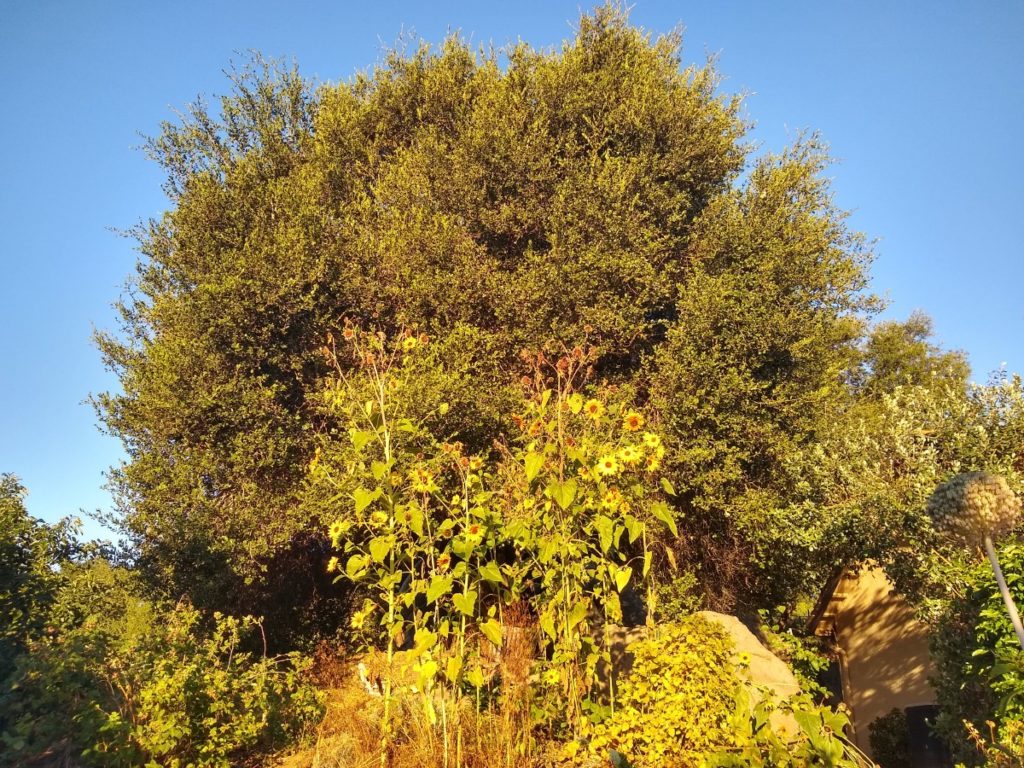
The sunflowers are drinking some of that berry water, and the bees say thank you.
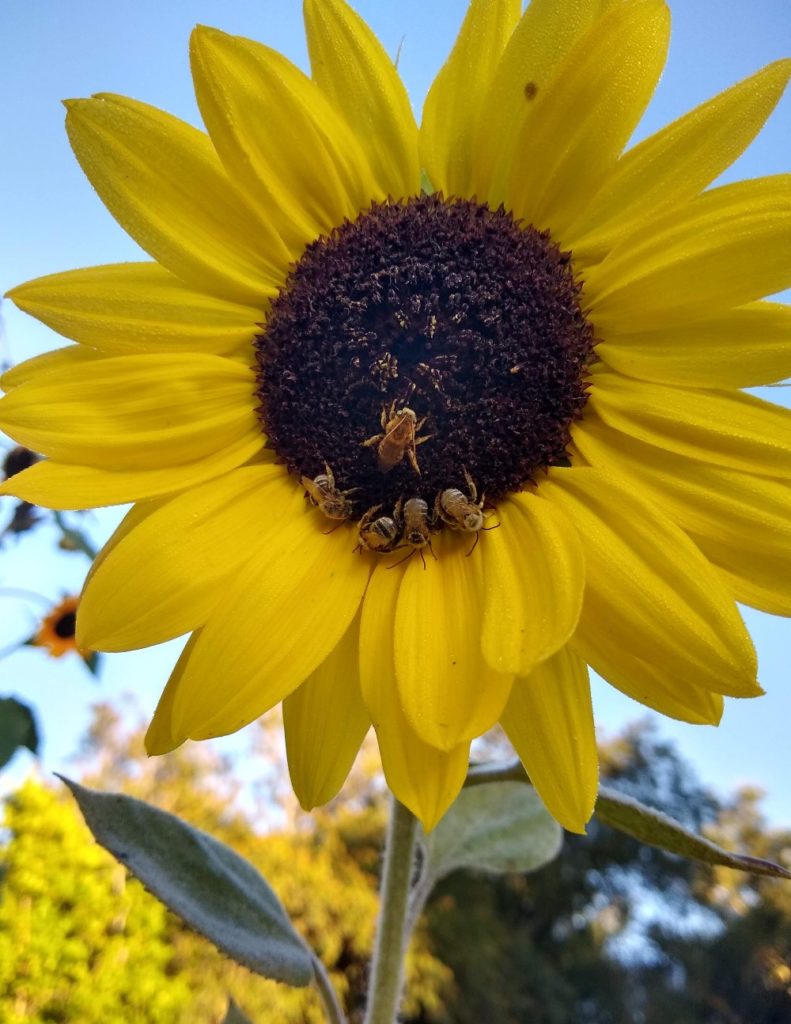
You might also like to read my post, “Oh, the mistakes I’ve made: Thinking flowers were for girls.”
A list with links to all of my Yard Posts is HERE

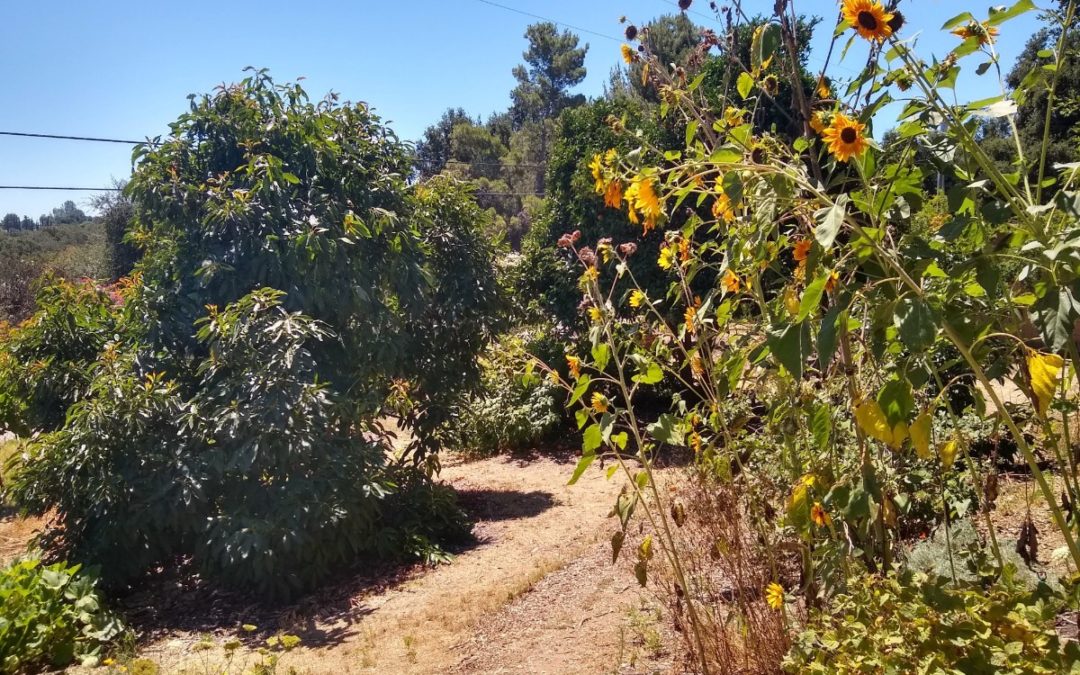


Thank you for these great photos! I forgot to sow seeds in spring but maybe I’ll toss out a few now and see what happens. The native bee pics are great. I live in Long Beach and we have lots of tiny native waspy bees, native flies and only occasional do I see native bumbles. I planted a native garden a year and a half ago so I am still hopeful we can support a local population. But I also have always welcomed mud and paper wasps. I just learned they aren’t actually native. They kill alot of native caterpillars. Do they also edge out native bees? What are your thoughts on those guys? They seem to be only passive pollinators so I am wondering about not being so welcoming of them under our eaves
Hi Amy,
I don’t know much about mud daubers and paper wasps, but when we’ve had them in our yard they’ve never caused a noticeable problem. You might like reading this page about them at the U.C. I.P.M. website: http://ipm.ucanr.edu/PMG/PESTNOTES/pn7450.html
I too grew 10 sunflowers this year.Never again all the bees hang around them all day.
but the bees don’t pollinate anything else.My watermelon flowers are all open but the bees won’t leave the sunflowers.Only one watermelon with all those vines.
Hello,
Thanks for sharing with us here in Los Angeles what seed varieties you planted.
I feel quite sad today as I found the head of the only sunflower that’s grown so far missing. Someone cut it off. Someone walked up our path…up to the front of the house, and ripped the head off. It’s hard for me to grow sunflowers here in our garden and this partifcular plant took 5 months. I was enjoying its beauty and felt so excited to let it self-sow…I even didn’t mind that finches came to peck at its leaves. Bees and maybe even hummingbirds were enjoying it. Bad juju to whomever stole it. they could have just asked if I could share some seeds.
I hope I will plant more next year. But for today, I just feel sad.
I’m sorry, J. Sad story. I hope that you don’t wait until next year to plant new sunflowers. There’s still time this year to plant new ones. Do it for the finches and bees.
Did the variegated sunflower have blossoms? Did they look normal?
Hi J,
I too live in Los Angeles and have found many missing heads to sunflowers along with missing tomatoes. Given the inaccessibility of my garden to other people, I attribute the losses to either the plentiful rats and squirrels of the city.
Thanks for sharing. Did you find a way to protect the heads?
Did you collect seeds from the variegated sunflower? I’ve had success with growing the Sunspots variety that’s the dwarf variegated one from seed. Yea not all the seedlings will be variegated but it’s usually 50/50. If you collected any would you want to trade seeds?
Hi Mark,
I didn’t collect any seeds, but new plants have grown up in the same spot and none are variegated. I’ll keep an eye out for any that sprout later this summer.
IMG_2486.JPG
I took this photo on January 13, 2022. This sunflower grew by itself in my garden, likely from birdseed that my husband gives our urban backyard birds. Temperature at this time range from 49 to 73 degrees Fahrenheit. I live in Southern California.
Hi Greg! I’m planning on planting some sunflower seeds I got from the store. Do they need to germinate before being planted into the ground?
Hi Cailin,
No. You can sow the seed directly in the ground if you want. But you can also sow them in little containers and then transplant them later, which is what I’m doing with my sunflowers at the moment because I need to put little cages around them or else the rabbits in my yard will likely eat them.
I’m in Morongo Valley California and last year I planted Sunflowers and they did well in this sandy soil and heat. Over 100 most of the summer. This year I want to plant them in fabric pots so I can manage them better. How do you feel about growing in containers
Hi Lois,
I’ve never grown sunflowers in containers, but I imagine it can be done as long as the container is big enough. You might also try using smaller varieties of sunflowers.
I don’t get as hot as you, but I have also noticed that sunflowers don’t mind when it’s over 100.
I live in Lakewood and I’ve grown sunflowers in containers and have had no problems. Will be direct sowing my seeds next week.
I planted a seed packet of sunflowers this year and now have some beautiful flowers to enjoy. I live in Orange County Southern California. Is it too late for me to plant more from seeds.
Hi Megan,
Not at all. I’m planting more right now too.